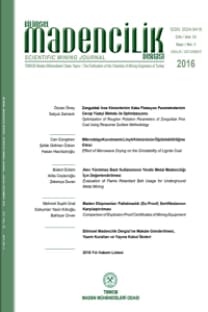KOSOVA FERZOVİK BELEDİYESİ’NİN BİRKAÇ KIRSAL ALANINDA İÇME SUYU KALİTESİNİN BELİRLENMESİ
Öz Suspicions of diverse pollution of groundwater in the villages of Dremjak, Talinoc i Muhaxherve, Softaj, Gërlicë and Varosh of the Ferizaj municipality motivated the investigation of empirical quality of the water wells from which the inhabitants of the villages provided drinking water. Considering that drinking water is the basic element for humans to live, its testing prior to consumption is necessary, therefore, this groundwater is the focus of this research. The samples were taken from the pumping stations, where underground waters were collected. The water was tested for organoleptic, physicochemical, and microbiological parameters, and during the analysis the classical analytical and instrumental methods were applied. The results of the analyses were compared with the Administrative Directive No. 16/2012 of Kosovo and the Instruction No. 98/83 of the EU, based on the standard values of the water quality consumed by humans. Both are in line with the standards of the World Health Organization for drinking water quality. It was determined that the groundwater in the respective five villages was contaminated with heavy metals (Fe, Pb, Mn, Cd and Ni). The water samples taken for analysis based on the underground map of the region show that the underground layers contain metals to some extent. Therefore, the presence of such metals in water is due to geological pollution. However, other organoleptic, physico-chemical and microbiological parameters are compatible with reference values.
Anahtar Kelimeler:
Drinking water, Water quality, Ferizaj villages, Heavy metals
DETERMINING THE DRINKING WATER QUALITY IN SEVERAL RURAL SETTLEMENTS IN FERIZAJ MUNICIPALITY, KOSOVA
___
- APHA, AWWA, WEF, 2005. Standard Methods for the Examination of Water and Wastewater, 21stEdition. New York. American Public Health Association.page 70.
- ATSDR (Agency for Toxic Substances and Disease Registry), 2015. Toxic Substances Portal.
- Çullaj, A., 2010. Kimia e Mjedisit.Tiranë.
- EU’s 1998. Drinking Water Standards. Council Directive 98/83/EC on the Quality of Water Intended for Human Consumption. Adopted by the Council, on 3 Nov. 1998
- Fawell, J., Nieuwenhuijsen, M. J., 2003. Contaminants in Drinking Water.British Medical Bulletin. Vol. 68: 199- 208.
- Gemitzi, A., Petalas, C., Tsihrintzis, V. A., Pisinaras, V., 2006. Assessment of Groundwater Vulnerability to Pollution: aCombination of GIS, Fuzzy Logic and Decision-Making Techniques. Environmental Geology. Vol. 49. Issue 5 p. 653-673
- ISO 5667-1: 2006. Water Quality -- Sampling -- Part 1: Guidance on the Design of Sampling Programmes and Sampling Techniques.
- ISO 5667-3: 2012. Water Quality -- Sampling -- Part 3: Preservation and Handling of Water Samples.
- ISO 5667-11: 2009. Water Quality -- Sampling -- Part 11: Guidance on Sampling of Groundwaters.
- ISO 6222:1999. Water quality — Enumeration of CulturableMicro-Organisms — Colony Count by Inoculation in a Nutrient AgarocultureMedium.
- McDermid, J.M., Lönnerdal, B., 2012. Iron. Adv Nutr. 3. pp.532-533.
- Meuli, C., Wehrle, K., 2001. Spring Catchment. (Series of Manuals on Drinking Water Supply, 4). St. Gallen: Swiss Centre for Development Cooperation in Technology and Management (SKAT).
- Plani I Zhvillimit Komunal. 2017-2025 i Komunës së Ferizajt. September 2017. Directorate for Urbanism, Planning and Environment, in cooperation with other municipal directorates and sectors. Professionally the document was supported by the consulting company “INSI” Sh.p.k. Ferizaj.
- Rajković M. B., 2003. Neke Neorganske Supstance Koje Se Mogu Naći U Vodi Za Piće I Posledice Po Zdravlje Ljudi. Hemijska industrija. 57(1) s. 24-34.
- Regli S. 2007. Proceedings on Research on Microorganisms in Drinking Water Progress Review Workshop. SDWA Requirements & Microbial Research Needs (Surface Water, Ground Water, & Distribution Systems) Stig Regli-U.S. Environmental Protection Agency.Office of Water/Office of Ground Water and Drinking Water.
- Robards M. Worsfold P. 1991. Cadmium Toxicology And Analysis - A review: Analyst 116: 549-560.
- Terrence T., John F., Shoichi K., Darryl J., Stephen A., Philip C. 2007. Chemical Safety of Drinking Water: Assessing Priorities For Risk Management. World Health Organ. Geneva.
- Thomas M. 2000. The Effect of Residential Development on Groundwater Quality Near Detroit. Michigan. J. Am Water Resour Assoc. 36. pp. 023-1038.
- UA 16/2012. Administrative Instruction No. 16/2012
- (AI 16/2012) on the human consume water quality for human consumption.
- US EPA Method 3015, 1994 Microwave Assisted Acid Digestion of Aqueous Samples and Extracts. ‘Skip’ Kingston. Duquesne University. Pittsburgh. PA USA. Final Version September.
- Verma, A., Thakur, B., Katiyar, S., Singh, D., Rai, M., 2013. Evaluation of ground water quality in Lucknow.
- Uttar Pradesh using remote sensing and geographic information systems (GIS). International Journal of Water Resources and Environmental Engineering.Vol. 5. Issue 2. p. 67-76.
- WHO 2011.Guidelines For Drinking-Water Quality.4th ed. Geneva.World Health Organization.ISBN 978 92 4 154815 1 pp. 541.
- ISSN: 2564-7024
- Yayın Aralığı: Yılda 4 Sayı
- Yayıncı: TMMOB Maden Mühendisleri Odası
Sayıdaki Diğer Makaleler
TRİBOELEKTROSTATİK AYIRMA İLE İNCE BOYDA KÖMÜR ZENGİNLEŞTİRİLMESİNİN İNCELENMESİ
Ergin GÜLCAN, T.onur DİZDAR, Özcan Y. GÜLSOY
Ebu Bekir AYGAR, Candan GÖKÇEOĞLU
PATLATMA KAYNAKLI PARÇALANMA MODELLERİNİN BİR KUMTAŞI OCAĞINDA İNCELENMESİ
Türker HÜDAVERDİ, Özge AKYILDIZ
KOSOVA FERZOVİK BELEDİYESİ’NİN BİRKAÇ KIRSAL ALANINDA İÇME SUYU KALİTESİNİN BELİRLENMESİ
Sadija KADRİU, Milaim SADİKU, Mensur KELMENDİ, Donika IBİSHİ
